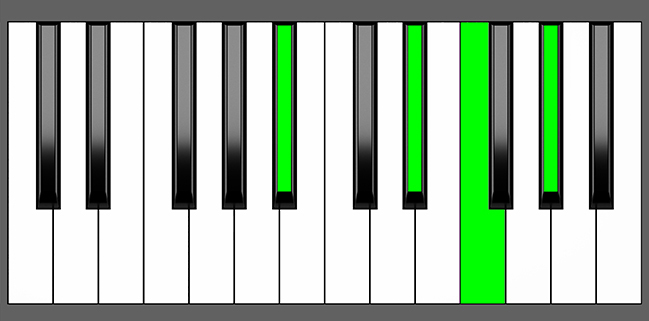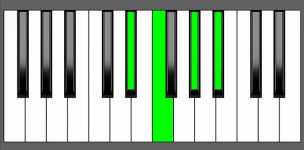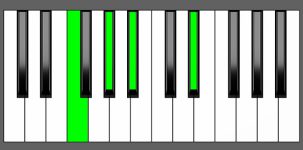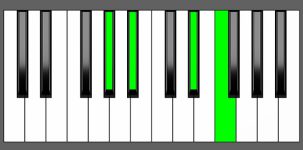Piano Diagram of Bb7sus4 in Root Position

The Bb7sus4 chord is made up of four notes, namely Bb, Eb, F, and Ab. This chord is known as a suspended second chord since the third note in the chord is substituted with a perfect fourth which creates a sense of suspension. To play the Bb7sus4 chord on a piano, you simply need to replace the third note (D) of a Bb7 chord with the fourth note (Eb) from its root. Keep reading to get a better understanding of the music theory principles behind this chord.
Structure of Bb7sus4
Notes |
|---|
| Bb, Eb, F, Ab |
Intervals |
|---|
| R, 4, 5, m7 |
Fingers Position
Left Hand |
|---|
| 5, 3, 2, 1 |
Right Hand |
|---|
| 1, 2, 3, 5 |
Bb7sus4 Chord Inversions
The Bb7sus4 chord has a total of 3 inversions:
| Root Position: | Bb | Eb | F | Ab |
| 1st Inversion: | Eb | F | Ab | Bb |
| 2nd Inversion: | F | Ab | Bb | Eb |
| 3rd Inversion: | Ab | Bb | Eb | F |
Piano Keyboard Diagrams
Music Theory and Harmony of Bb7sus4
What are Suspended Chords?
Suspended chords are a type of chord in which the third note is replaced by either a major second or a perfect fourth. These resulting chords are called suspended second (sus2) or suspended fourth (sus4) chords, respectively. These chords create a unique and sometimes unresolved sound that can add tension and interest to a musical composition.
Suspended chords have a distinct sound that sets them apart from major and minor chords. They are called suspended chords because they temporarily suspend the listener’s expectation of hearing a major or minor stable chord. Instead, they feature a perfect fourth or major second interval in place of the third. Due to their “neutral nature,” suspended chords can sometimes be used as substitutes for both major and minor chords.
The 7sus4 chord is a more intricate and richer version of sus4 chords, thanks to the inclusion of an extra minor 7th note. This additional note makes 7sus4 chords a more suitable choice for dominant and minor 7th chords.
Building the Bb7sus4 Chord: Different Approaches
Starting from the Bb major Scale
To build a 7sus4 chord, you can use the major scale as a guide and combine a root note, a perfect 4th, a perfect 5th, and a minor 7th interval.


To create a Bb7sus4 chord, apply the formula R, 4, 5, m7 in the following manner:
- Begin with the Root note, Bb.
- Select the 4th interval, Eb.
- Add the 5th note, F.
- Finally, add the minor 7th interval, which is Ab.
By following this simple formula, you can create a 7sus4 chord from any major scale.
by Combining Intervals
One method to create a dominant suspended 4th chord is by combining three specific intervals – a perfect 4th, a major 2nd, and a minor 3rd.
4 + 2 + m3 = 7sus4 Chords
To illustrate, let’s use the Bb7sus4 chord as an example. By examining the intervals between the notes, we can see that Bb-Eb forms a perfect 4th interval, Eb-F creates a major second interval, and the interval between F and Ab is a minor 3rd.
How to Use Bb7sus4 in a Chord Progression
Suspended chords have a unique quality that sets them apart from major and minor chords. They are considered neither major nor minor, which makes them a great tool for creating tension and suspense in a musical composition before resolving to a stable major or minor chord.
To incorporate a Bb7sus4 into a chord progression, you can refer to the following tables, which outline the most common positions where the chord can be found or utilized.
However, it’s crucial to understand that, since this chord contains a minor 7th, it isn’t compatible with Maj7 chords, unlike sus2 or sus4 chords. Nevertheless, it can be used on dominant chords and on all positions where a Bbm7 is present.
Bb7sus4 as Substitute of Bb7
Bb7sus4 can be used as a substitute for Bb7 in major and minor keys. In Eb major, Bb7 can be replaced with Bb7sus4 in the V position. Similarly, in the C minor key, Bb7 can be substituted with Bb7sus4 in the VII position which is the leading tone chord.
on Major Scales
| Major Scales | I | ii | iii | IV | V | vi | vii |
|---|---|---|---|---|---|---|---|
| Eb | Eb Maj7 | F min7 | G min7 | Ab Maj7 | Bb7 ⇒ Bb7sus4 | C min7 | Dm7b5 |
- Dominant chord in Eb Major
on Natural minor Scales
| Minor Scales | i | ii | III | iv | v | VI | VII |
|---|---|---|---|---|---|---|---|
| C | C min7 | Dm7b5 | Eb Maj7 | F min7 | G min7 | Ab Maj7 | Bb7 ⇒ Bb7sus4 |
- Leading tone chord in C minor
Bb7sus4 as Substitute of Bb min7
Bb7sus4 chord can be used as a substitute for Bb minor 7th in various major and natural minor scales:
on Major Scales
| Major Scales | I | ii | iii | IV | V | vi | vii |
|---|---|---|---|---|---|---|---|
| Ab | Ab Maj7 | Bbm7 ⇒ Bb7sus4 | C min7 | Db Maj7 | Eb7 | F min7 | Gm7b5 |
| Gb | Gb Maj7 | Ab min7 | Bbm7 ⇒ Bb7sus4 | Cb Maj7 | Db7 | Eb min7 | Fm7b5 |
| Db | Db Maj7 | Eb min7 | F min7 | Gb Maj7 | Ab7 | Bbm7 ⇒ Bb7sus4 | Cm7b5 |
- Supertonic chord in Ab Major
- Mediant chord in Gb Major
- Submediant chord in Db Major
on Natural minor Scales
| Minor Scales | i | ii | III | iv | v | VI | VII |
|---|---|---|---|---|---|---|---|
| Bb | Bbm7 ⇒ Bb7sus4 | Cm7b5 | Db Maj7 | Eb min7 | F min7 | Gb Maj7 | Ab7 |
| F | F min7 | Gm7b5 | Ab Maj7 | Bbm7 ⇒ Bb7sus4 | C min7 | Db Maj7 | Eb7 |
| Eb | Eb min7 | Fm7b5 | Gb Maj7 | Ab min7 | Bbm7 ⇒ Bb7sus4 | Cb Maj7 | Db7 |
- Tonic chord in Bb minor
- Subdominant chord in F minor
- Dominant chord in Eb minor
Bb7sus4 Chord Function in Major and Minor Keys
Understanding Scale Degrees
When creating chords from a scale, each note in the scale is assigned a degree, which reflects its position in the scale. In the diatonic major scale, there are seven degrees, and each degree has a unique role in the overall harmony of the scale.
- The first degree of the scale is called the Tonic, and it serves as the foundation for the scale. It provides a stable tonal center and is often referred to as the “home base” of the music.
- The second degree of the scale is called the Supertonic. It’s typically used as a passing note between the tonic and other scale degrees, and it adds a sense of movement to the melody or harmony.
- The third degree of the scale is called the Mediant. It’s located halfway between the tonic and dominant notes and helps to establish whether the scale is major or minor.
- The fourth degree of the scale is called the Subdominant. It’s often used as a complementary harmony to the dominant and adds a sense of tension and resolution to the music.
- The fifth degree of the scale is called the Dominant. It generates tension and a sense of expectation, and it’s typically resolved by returning to the tonic.
- The sixth degree of the scale is called the Submediant. It’s often utilized as a transition between the dominant and tonic, and it provides a sense of stability and restfulness to the music.
- The seventh degree of the scale is called the Leading tone. It’s located one half step below the tonic and produces a strong sense of tension and a desire to resolve to the tonic. It’s often used to create a sense of resolution and finality in the melody or harmony.
Understanding the scale degrees is important for creating chords and understanding how they relate harmonically to each other.
Bb7sus4 in Eb Major
In the key of Eb Major, the fifth degree is Bb7. However, by using a Bb7sus4 chord instead, you can create a sense of tension and expectation, which can then be resolved by returning to the dominant chord or another degree of the scale.
| I | ii | iii | IV | V | vi | vii |
| Eb Maj7 | F min7 | G min7 | Ab Maj7 | Bb7 | C min7 | Dm7b5 |
Bb7sus4 as V degree – Chord Progressions
ii V I
| ii | V | I |
| F min7 | Bb7sus4 | Bb7 | Eb Maj7 |
You can experiment with different ways of playing the Bb7sus4 chord in the key of Eb Major. For example, you could play just the Bb7sus4 chord, or split the measure in half and play both the Bb7sus4 and Bb7 chords. Another option is to invert the order of the chords, playing the Bb7 chord first and then resolving to the Bb7sus4 chord.
I IV V
| I | IV | V |
| Eb Maj7 | Ab Maj7 | Bb7sus4 | Bb7 |
I V vi IV
| I | V | vi | IV |
| Eb Maj7 | Bb7sus4 | Bb7 | C min7 | Ab Maj7 |
I IV vi V
| I | IV | vi | V |
| Eb Maj7 | Ab Maj7 | C min7 | Bb7sus4 | Bb7 |
I IV ii V iii vi ii V
| I | IV | ii | V | iii | vi | ii | V |
| Eb Maj7 | Ab Maj7 | F min7 | Bb7sus4 | Bb7 | G min7 | C min7 | F min7 | Bb7sus4 | Bb7 |
Bb7sus4 in C Minor
In the key of C minor, the seventh degree features a Bb7 chord. Adding a Bb7sus4 chord can create a sense of anticipation and tension, preparing the listener for the resolution to the tonic chord. You can experiment with playing just the Bb7sus4 chord or combining it with the Bb7 chord.
| i | ii | III | iv | v | VI | VII |
| C min7 | Dm7b5 | Eb Maj7 | F min7 | G min7 | Ab Maj7 | Bb7 |
Bb7sus4 as VII degree – Chord Progressions
i VI VII
| i | V | VII |
| C min7 | G min7 | Bb7sus4 | Bb7 |
i v VI VII
| i | v | VI | VII |
| C min7 | G min7 | Ab Maj7 | Bb7 | Bb7sus4 |
i III VII VI
| i | III | VII | VI |
| C min7 | Eb Maj7 | Bb7sus4 | Bb7 | Ab Maj7 |
Circle Progression
| i | iv | VII | III | VI | ii | V7 | i |
| C min7 | F min7 | Bb7sus4 | Bb7 | Eb Maj7 | Ab Maj7 | Dm7b5 | G7 | C min7 |
Bb7sus4 in Ab Major
In the context of Ab Major key, the second chord in the key is typically a Bb minor chord. However, incorporating a Bb7sus4 chord instead of Bbm can add some variation and tonal interest to a chord progression.
| I | ii | iii | IV | V | vi | vii |
| Ab Maj7 | Bb min7 | C min7 | Db Maj7 | Eb7 | F min7 | Gm7b5 |
Bb7sus4 Chord Progressions as ii degree
ii V I
| ii | V | I |
| Bb7sus4 | Bbm7 | Eb7 | Ab Maj7 |
I IV ii V iii vi ii V
| I | IV | ii | V | iii | vi | ii | V |
| Ab Maj7 | Db Maj7 | Bb7sus4 | Bbm7 | Eb7 | C min7 | F min7 | Bbmin7 | Bb7sus4 | Eb7 |
Bb7sus4 in Gb Major
When playing in the key of Gb Major, the Bb7sus4 chord can be used as a chord substitution for the diatonic Bb minor chord that normally appears on the III degree of the scale.
| I | ii | iii | IV | V | vi | vii |
| Gb Maj7 | Ab min7 | Bb min7 | Cb Maj7 | Db7 | Eb min7 | Fm7b5 |
Bb7sus4 Chord Progressions as iii degree
I iii IV V
| I | iii | IV | V |
| Gb Maj7 | Bb7sus4 | Bbm7 | Cb Maj7 | Db7 |
I iii ii V
| I | iii | ii | V |
| Gb Maj7 | Bb7sus4 | Bbm7 | Ab min7 | Db7 |
I iii vi IV
| I | iii | vi | IV |
| Gb Maj7 | Bb7sus4 | Bbm7 | Eb min7 | Cb Maj7 |
Bb7sus4 in Db Major
In the key of Db Major, the Bb7sus4 chord can function as a submediant chord, which means it’s a chord built on the sixth degree of the scale. It can add variety and interest to a chord progression that already includes a Bbm chord on the sixth degree.
| I | ii | iii | IV | V | vi | vii |
| Db Maj7 | Eb min7 | F min7 | Gb Maj7 | Ab7 | Bb min7 | Cm7b5 |
Bb7sus4 as vi degree – Chord Progressions
I iii vi V
| I | iii | vi | V |
| Db Maj7 | F min7 | Bb7sus4 | Bbm7 | Ab7 |
I vi ii V
| I | vi | ii | V |
| Db Maj7 | Bb7sus4 | Bbm7 | Eb min7 | Ab7 |
I IV ii V iii vi ii V
| I | IV | ii | V | iii | vi | ii | V |
| Db Maj7 | Gb Maj7 | Eb min7 | Ab7 | F min7 | Bb7sus4 | Bbm7 | Eb min7 | Ab7 |
Bb7sus4 in Bb Minor
When using the Bb7sus4 chord in the key of Bb minor, it can serve as a variation of the traditional Bbm chord.
| i | ii | III | iv | v | VI | VII |
| Bb min7 | Cm7b5 | Db Maj7 | Eb min7 | F min7 | Gb Maj7 | Ab7 |
Bb7sus4 Chord Progressions as i degree
i VI VII
| i | VI | VII |
| Bb7sus4 | Bbm7 | Gb Maj7 | Ab7 |
i iv VI VII
| i | iv | VI | VII |
| Bb7sus4 | Eb min7 | Gb Maj7 | Ab7 |
Bb7sus4 in F Minor
When playing in the key of F minor, you can try using the Bb7sus4 chord as a substitution or variation for the Bb major chord on the IV degree.
| i | ii | III | iv | v | VI | VII |
| F min7 | Gm7b5 | Ab Maj7 | Bb min7 | C min7 | Db Maj7 | Eb7 |
Bb7sus4 Chord Progressions as iv degree
iv III VI VII
| iv | III | VI | VII |
| Bb7sus4 | Bbm7 | Ab Maj7 | Db Maj7 | Eb7 |
i iv VI v
| i | iv | VI | v |
| F min7 | Bb7sus4 | Bbm7 | Db Maj7 | C min7 |
Bb7sus4 in Eb Minor
In the key of Eb minor, the Bb7sus4 chord can function as a substitution or variation for the fifth chord, adding a unique tonal color to the progression. Pairing it with the Bb7 chord on the fifth degree can create a sense of tension and expectation for the resolution to the tonic chord or to another chord of the scale.
| i | ii | III | iv | v | VI | VII |
| Eb min7 | Fm7b5 | Gb Maj7 | Ab min7 | Bb min7 | Cb Maj7 | Db7 |
Bb7sus4 as v degree – Chord Progressions
i iv VI v
| i | iv | VI | v |
| Eb min7 | Ab min7 | Cb Maj7 | Bb7sus4 | Bbm7 |
i v VI VII
| i | v | VI | VII |
| Eb min7 | Bb7sus4 | Bbm7 | Cb Maj7 | Db7 |
i VI v iv
| i | VI | v | iv |
| Eb min7 | Cb Maj7 | Bb7sus4 | Bbm7 | Ab min7 |
Alternative Names for Bb7sus4 Chord
- Bb7sus4
- Bb7sus(4)
- Bb7 add4(no3)
- Bb7 add4(omit3)
- Bb Dominant Suspended 4th



